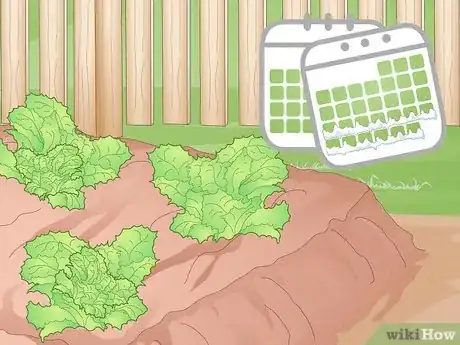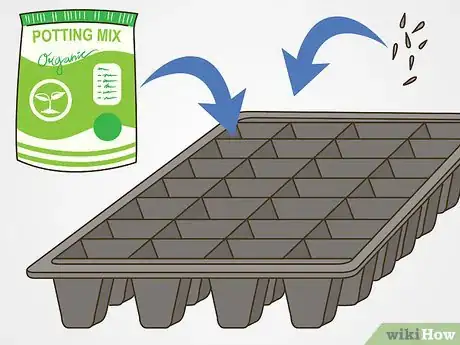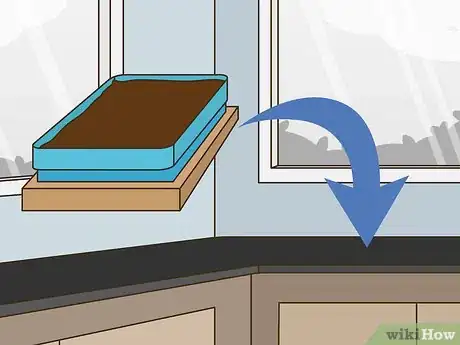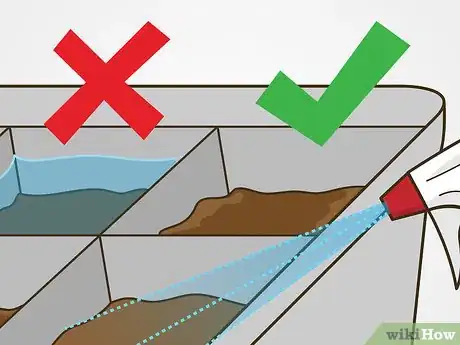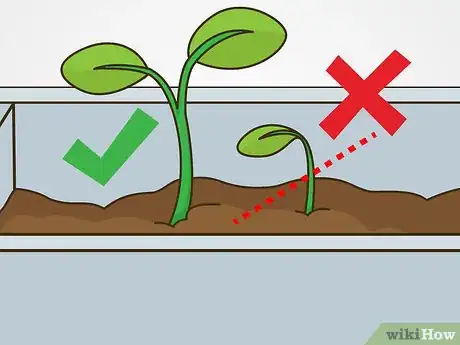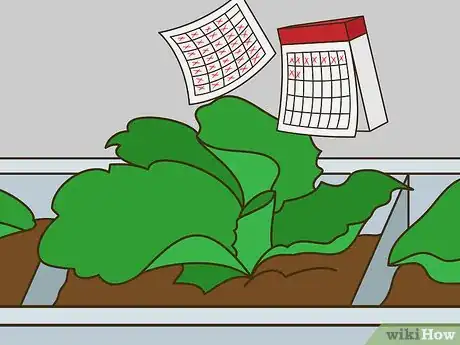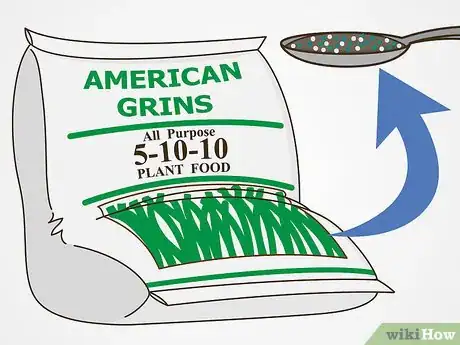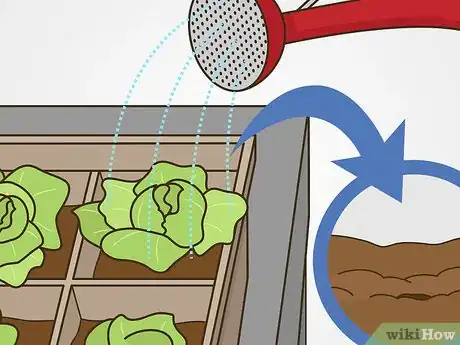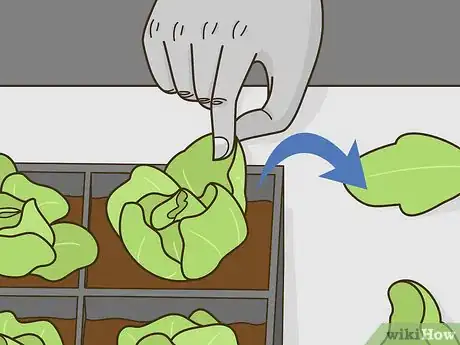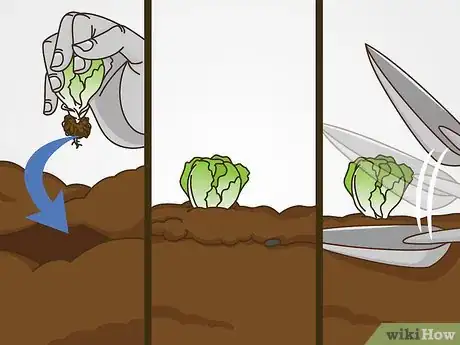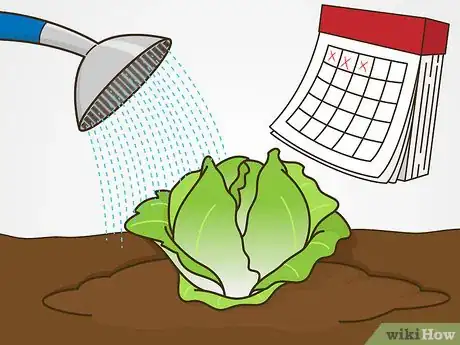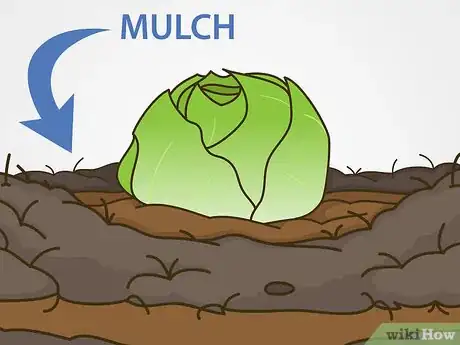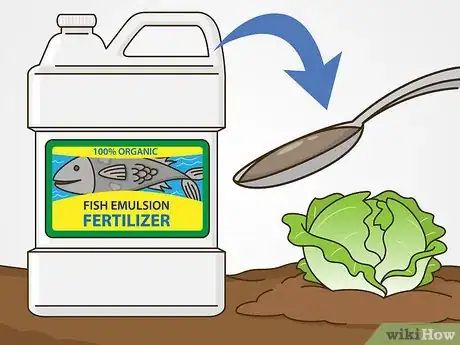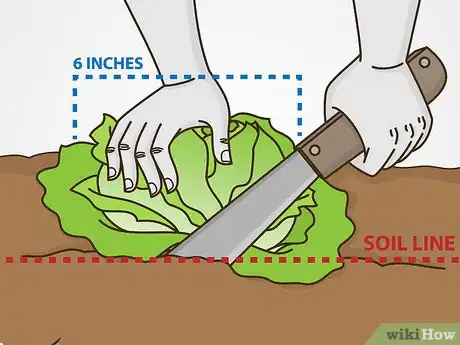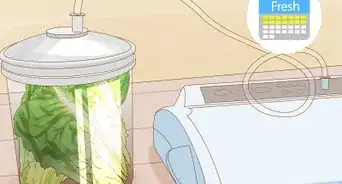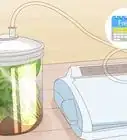This article was co-authored by Lauren Kurtz and by wikiHow staff writer, Kyle Hall. Lauren Kurtz is a Naturalist and Horticultural Specialist. Lauren has worked for Aurora, Colorado managing the Water-Wise Garden at Aurora Municipal Center for the Water Conservation Department. She earned a BA in Environmental and Sustainability Studies from Western Michigan University in 2014.
This article has been viewed 168,394 times.
Iceberg lettuce is great in salads, wraps, and a variety of other recipes. Growing your own iceberg lettuce is simple, especially when you keep the seedlings indoors for the first couple of months. By keeping the lettuce cool and moist, and growing it at the right time of year, you’ll have crisp, refreshing iceberg lettuce you can harvest right from your garden.
Steps
Planting the Seeds
-
1Plant the iceberg lettuce six to eight weeks before the last expected spring frost. Don't plant the lettuce during the early winter or summer, or it will struggle to grow because of the extreme temperatures.
- If you don't know when the last expected spring frost is in your area, look it up online. For example, you could search "average last spring freeze dates for Kansas City."
-
2Plant iceberg lettuce seeds in a shallow seed tray. Fill the bottom of each cell of the tray with some standard potting soil before you sprinkle a few seeds into each cell. Cover the seeds with with a light layer of potting soil.[1]Advertisement
-
3Place the seed tray indoors in a sunny area. Put the tray by a window or in a bright room where the seeds will get around twelve hours of sunlight. If you don't have much direct sunlight, you can use indoor grow lights as well.[2]
-
4Keep the soil the seeds are planted in moist soil. Check the seed tray every day, and water the seeds whenever the soil feels dry. You want the soil to be moist but not soaked. If there's standing water on top of the soil, the seeds could rot.[3] In five to ten days you should see the lettuce beginning to sprout.[4]
-
5Use scissors to cut the lettuce sprouts so there’s only one per cell. Once all of the seedlings have sprouted, cut off the extra sprouts at the level of the soil’s surface.[5]
-
6Let the lettuce grow indoors for six weeks. After six weeks, the lettuce plants should be large enough to transplant outside.[6]
Transplanting the Lettuce
-
1Slowly acclimate the lettuce to being outside. After letting the lettuce mature for six weeks, start setting the tray of lettuce outside in a sheltered location for three hours a day. Each day, leave the tray of lettuce outside for two hours longer than the day before. The lettuce plants will be acclimated once they’ve been left outside for a full day. The entire acclimation process should take around a week.[7]
- Don't leave the lettuce out at night until they have completely acclimated to the outdoors. This will typically be at the end of the process.
- It's OK if the weather hasn't completely warmed at this point. Properly acclimating the lettuce will help it develop a resistance to cooler temperatures. You should not plant the lettuce outside, however, until you are certain that there will not be another frost.[8]
-
2Dig 5 inch (12.7 cm) holes in a patch of your garden for each seedling. Organize the holes in staggered rows, making the holes 10 inches (25.4 cm) apart. Don’t make the patch any wider than 20 inches (50.8 cm).[9]
- Plant the lettuce in a part of your garden with rich, well-drained soil that has full sun exposure.[10]
-
3Add a tablespoon of 5-10-10 fertilizer to each hole. 5-10-10 fertilizer contains 5 percent nitrogen, 10 percent phosphorous, and 10 percent potassium. If you don’t have fertilizer, use a handful of compost or dried manure instead.[11]
-
4Water the seed tray before you transfer the lettuce seedlings. Don’t try to transfer them when they’re dry or the soil will crumble and fall off around their roots.[12]
-
5Pull the outer leaves off the lettuce seedlings before you transfer them. This will make the plants lighter so their growing roots can support them in the ground more easily. Leave the sprouts at the center of the plants intact; they will go on to form the lettuce heads.[13]
-
6Plant the seedlings in the holes. Plant them so they're at the same depth as when they were in the tray. Fill in the holes with soil and gently pack down the soil around the base of the plants with your hands.[14]
-
7Lightly water the lettuce seedlings. Continue to water them daily for the first three days after you transplant them.[15]
Caring for the Lettuce
-
1Water the lettuce three to four times a week to keep the soil moist. Don’t worry about watering this much if you’re experiencing a lot of rain. The goal is to keep the lettuce cool and moist; dried out lettuce may develop a bitter taste or rot. If the surface of the soil looks dry, it hasn't been watered enough.[16]
- Never water the lettuce more often than this or it might develop rot. You may also want to avoid watering in the evening.
-
2Add a 2-3 inch (5.8-7.6 cm) layer of mulch over the soil around the lettuce. Use an organic mulch, like chopped leaves or compost, to keep the lettuce cool and protect it from the heat during the spring and summer.[17]
-
3Apply a 5-10-10 fertilizer to the lettuce every three to four weeks. Find a fertilizer at your local gardening center, or use an organic fertilizer like cottonseed meal or fish emulsion. Lightly apply a thin layer of the fertilizer to the soil surrounding the lettuce.[18] If you’d prefer to use a chemical fertilizer, a granular or spray fertilizer works well for outdoor vegetable plants.[19]
-
4Cut the lettuce at the soil line to harvest the head. The lettuce is ready to harvest when it's firm and full grown, or about 6 inches (15.24 cm) in diameter. Store the leaves in the refrigerator for 5-10 days.[20]
- Don't wait too long to harvest your lettuce or it could develop a bitter taste.
- Lettuce doesn't thrive in hot temperatures. You should make sure to harvest the lettuce before temperatures rise above 80 °F (27 °C).
Expert Q&A
Did you know you can get expert answers for this article?
Unlock expert answers by supporting wikiHow
-
QuestionCan I eat bolted lettuce?
 Lauren KurtzLauren Kurtz is a Naturalist and Horticultural Specialist. Lauren has worked for Aurora, Colorado managing the Water-Wise Garden at Aurora Municipal Center for the Water Conservation Department. She earned a BA in Environmental and Sustainability Studies from Western Michigan University in 2014.
Lauren KurtzLauren Kurtz is a Naturalist and Horticultural Specialist. Lauren has worked for Aurora, Colorado managing the Water-Wise Garden at Aurora Municipal Center for the Water Conservation Department. She earned a BA in Environmental and Sustainability Studies from Western Michigan University in 2014.
Professional Gardener
-
QuestionMy iceberg lettuce is growing tall but not forming heads. What should I do?
 Lauren KurtzLauren Kurtz is a Naturalist and Horticultural Specialist. Lauren has worked for Aurora, Colorado managing the Water-Wise Garden at Aurora Municipal Center for the Water Conservation Department. She earned a BA in Environmental and Sustainability Studies from Western Michigan University in 2014.
Lauren KurtzLauren Kurtz is a Naturalist and Horticultural Specialist. Lauren has worked for Aurora, Colorado managing the Water-Wise Garden at Aurora Municipal Center for the Water Conservation Department. She earned a BA in Environmental and Sustainability Studies from Western Michigan University in 2014.
Professional Gardener
-
QuestionWhat do I do with the leftover part of the lettuce plants after harvesting it?
 Community AnswerLeave the remainder of the plants in the soil of the garden to allow the nutrients of the plant matter to return to the soil for next year's garden. Removing all plant matter after growing a garden is very harmful to soil health and soil nutrient levels.
Community AnswerLeave the remainder of the plants in the soil of the garden to allow the nutrients of the plant matter to return to the soil for next year's garden. Removing all plant matter after growing a garden is very harmful to soil health and soil nutrient levels.
Things You'll Need
- Iceberg lettuce seeds
- Seed tray
- Potting mixture
- Scissors
- Gardening shovel
- Fertilizer
- Mulch
References
- ↑ http://www.gardenersnet.com/vegetable/iceberg.htm
- ↑ http://www.gardeners.com/how-to/growing-lettuce-indoors/8573.html
- ↑ http://www.gardenersnet.com/vegetable/iceberg.htm
- ↑ http://www.gardenersnet.com/vegetable/iceberg.htm
- ↑ http://www.gardenersnet.com/vegetable/iceberg.htm
- ↑ https://garden.org/learn/articles/view/430/
- ↑ https://garden.org/learn/articles/view/430/
- ↑ https://garden.org/learn/articles/view/430/
- ↑ https://garden.org/learn/articles/view/430/
- ↑ http://www.gardenersnet.com/vegetable/iceberg.htm
- ↑ https://garden.org/learn/articles/view/430/
- ↑ https://garden.org/learn/articles/view/430/
- ↑ https://garden.org/learn/articles/view/430/
- ↑ https://garden.org/learn/articles/view/430/
- ↑ https://garden.org/learn/articles/view/430/
- ↑ http://gardening.yardener.com/Caring-For-Lettuce
- ↑ https://garden.org/learn/articles/view/430/
- ↑ https://garden.org/learn/articles/view/430/
- ↑ http://gardening.yardener.com/Caring-For-Lettuce
- ↑ https://bonnieplants.com/product/head-lettuce-iceberg-type/
About This Article
To grow iceberg lettuce, start by filling a shallow seed tray with soil and sprinkling a few seeds in each cell a few weeks before the last frost. Then, place the tray in a sunny window and keep the soil moist. Next, acclimate the seedlings to being outside by placing them in a sheltered location for 3 hours the first day, then adding 2 more hours each day until they've been outside for a full day. At that point, remove the outer leaves from each seedling and plant them in a 5 inch deep hole with a tablespoon of fertilizer. Finally, water the plants daily for 3 full days. For tips from our Horticultural reviewer on how to mulch your lettuce to protect it from heat and keep it from bolting, read on!
